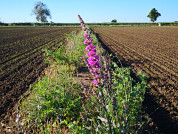Green field margins as a strategy to promote the diversity of natural enemies of pests on rice cropping
DOI:
https://doi.org/10.25260/EA.20.30.3.0.1122Keywords:
biodiversity, arthropods, insects, agriculture, pest control, sustainability, ecological intensificationAbstract
The increasing demand of environmentally-friendly produced food by society is motivating a change in the agricultural paradigm. The use of herbicides, although traditionally important for the control of weeds, may entail the loss of habitat for insect species that are potential allies of farmers, such as natural enemies of pests. To improve the diversity of natural enemies of pests, an alternative practice could be to avoid the use of herbicides in those areas where weeds do not compete directly with the crop, such as the field margins. To investigate this question, we evaluated how the presence of natural vegetation on rice field margins in the Ebro Delta affects the diversity (morphospecies richness) and abundance of arthropods that can potentially act as enemies of rice pests. We performed several arthropod samplings on rice margins with natural vegetation and rice margins with naked soil (herbicide treatments). Our results indicate that both the diversity and the abundance of arthropods was practically double in margins with natural vegetation (morphospecies richness: 35.3±2.1; abundance: 124±62) than in margins that had been treated with herbicides (21.0±9.6; 65±35). It is important to highlight that the chironomids group represents 84% ‘ of all the sampled arthropods when accounted for both types of margins. The rest of the arthropods detected do not pose a threat to rice cropping. On the contrary, most species can act as potential enemies of pests (e.g., syrphids, spiders, beetles or wasps among others). These results suggest that promoting green margins on rice fields can be a promising strategy for mitigating the loss of biodiversity while promoting biological control by natural enemies of pests.
References
Catala, M. M., N. Tomás, and E. Pla. 2013. Cómo cuantificar los quironómidos (Díptera: Chironomidae) en un arrozal: descripción de un método sencillo, rápido y fiable. Phytoma España: La Revista Profesional De Sanidad Vegetal 250:100-103.
Garibaldi, L. A., B. Gemmill-Herren, R. D’Annolfo, B. E. Graeub, S. A. Cunningham, and T. Breeze. 2017. Farming approaches for greater biodiversity, livelihoods and food security. Trends in Ecology and Evolution 32:68-80. https://doi.org/10.1016/j.tree.2016.10.001.
Garibaldi, L. A., N. Pérez-Méndez, M. P. Garratt, B. Gemmill-Herren, F. E. Miguez, and L. V. Dicks. 2019. Policies for ecological intensification of crop production. Trends in Ecology and Evolution 34(4):282-286.
Foley, J. A., N. Ramankutty, K. A. Brauman, E. S. Cassidy, J. S. Gerber, M. Johnston, N. D. Mueller, C. O’Connell, D. K. Ray, P. C. West, C. Balzer, E. M. Bennett, S. R. Carpenter, J. Hill, C. Monfreda, S. Polasky, J. Rockström, J. Sheehan, S. Siebert, D. Tilman, and D. P. M. Zaks. 2011. Solutions for a cultivated planet. Nature 478:337-342. https://doi.org/10.1038/nature10452.
Hajek, A. E., and J. Eilenberg. 2018. Natural enemies: an introduction to biological control. Cambridge University Press, Cambridge, UK. https://doi.org/10.1017/9781107280267.
Jarvis, D. I., C. Padoch, and H. D. Cooper (eds.). 2007. Managing biodiversity in agricultural ecosystems. Columbia University Press, Columbia, USA. https://doi.org/10.7312/jarv13648.
Ministerio de Agricultura, Pesca y Alimentación (MAPAMA). 2019. Encuesta sobre Superficies y Rendimientos Cultivos (ESYRCE) 2018.
Meyer, B., F. Jauker, and I. Steffan-Dewenter. 2009. Contrasting resource-dependent responses of hoverfly richness and density to landscape structure. Basic and Applied Ecology 10(2):178-186. https://doi.org/10.1016/j.baae.2008.01.001.
Oliver, I., and A. J. Beattie. 1996. Invertebrate morphospecies as surrogates for species: a case study. Conservation Biology 10(1):99-109. https://doi.org/10.1046/j.1523-1739.1996.10010099.x.
Rotheray, G. E., and F. Gilbert. 2011. The natural history of hoverflies. Forrest text, UK.
Schweiger, O., M. Musche, D. Bailey, R. Billeter, T. Diekötter, F. Hendrickx, F. Herzog, J. Liira, J‐P. Maelfait, M. Speelmans, and F. Dziock. 2007. Functional richness of local hoverfly communities (Diptera, Syrphidae) in response to land use across temperate Europe. Oikos 116(3):461-472. https://doi.org/10.1111/j.2007.0030-1299.15372.x.
White, T. C. R. 2008. The role of food, weather and climate in limiting the abundance of animals. Biological Reviews 83:227-248. https://doi.org/10.1111/j.1469-185X.2008.00041.x.
White, A. J., S. D. Wratten, N. A. Berry, and U. Weigmann. 1995. Habitat manipulation to enhance biological control of Brassica pests by hover flies (Diptera: Syrphidae). Journal of Economic Entomology 88(5):1171-1176. https://doi.org/10.1093/jee/88.5.1171.
Winfree, R., I. Bartomeus, and D. P. Cariveau. 2011. Native pollinators in anthropogenic habitats. Annual Review of Ecology, Evolution and Systematics 42:1-22. https://doi.org/10.1146/annurev-ecolsys-102710-145042.

Downloads
Additional Files
Published
How to Cite
Issue
Section
License
Copyright (c) 2020 Néstor Pérez-Méndez, Eva Pla, Nuria Tomás, Andrea Bartomeu, Oriol Ferré, Mar Catala-Forner

This work is licensed under a Creative Commons Attribution 3.0 Unported License.
Authors retain their rights as follows: 1) by granting the journal the right to its first publication, and 2) by registering the published article with a Creative Commons Attribution License (CC-BY 4.0), which allows authors and third parties to view and use it as long as they clearly mention its origin (citation or reference, including authorship and first publication in this journal). Authors can make other non-exclusive distribution agreements as long as they clearly indicate their origin and are encouraged to widely share and disseminate the published version of their work.


